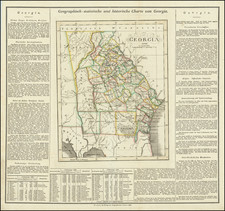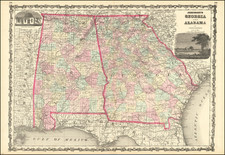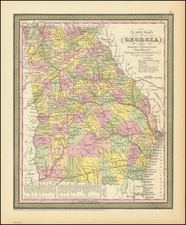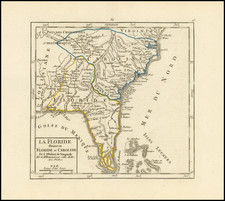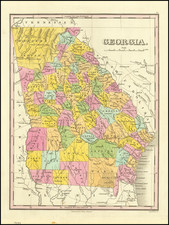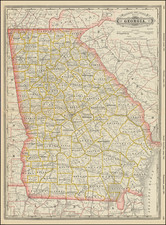William Bonner's Wall Map of Georgia
Rare first state of the first state of William G. Bonner's map of Georgia, the largest separately published map of Georgia prior to the Civil War.
This is the first state of William G. Bonner's map, engraved in New York by Sherman & Smith and published between 1847 and 1857. A revised final Bonner state of the map was issued in 1857 and printed by R.L. Barnes in Philadelphia, with a later state issued by James Butts in 1859.
The Florida-Georgia Boundary Dispute
The dispute over the boundary between the two states dated back to the Treaty of Paris in 1763, and was intended to have been established by the Treaty of 1795, between the US and Spain (and subsequent 1798-99 Joint Commission, whereby Andrew Ellicott (as US Commissioner) and Stephen Minor (as Spanish Commissioner) set the orginal boundary (subject to formal survey). Thereafter, several attempts were made by Georgia and Florida to survey the land between 1819 and 1854, without success. The dispute continued until 1857, when the governors of the two states had a conference which resulted in an agreement by which Georgia relinquished its claims to have the eastern terminus of the line changed; and the termini fixed by the commissioners, Ellicott and Minor, were substantially adopted.
William Bonner's Map of Georgia
Prior to 1847, the best large format map of Georgia was the Early-Sturges map of 1818. As Georgia grew in population and became increasingly more settled, the Georgia Legislature addressed necessity of an improved large format comprehensive map, which resulted in the retention of William G. Bonner to create such a map. Bonner, a civil engineer, constructed his map by compiling existing material available in Milledgeville and adding information received from county magistrates. As noted in several excerpts from the Macon Weekly Telegraph,
We have witnessed the progression of this work, since its commencement, almost daily. It has been executed at the Capitol, where reference has been easy to the statutes regulating boundary lines, and to all the surveys ever ordered by the State authorities (Novemer 24, 1846).
It appears that Mr. B[onner]. is exceedingly desirous of having a particularly correct outline of each county, with all the public places therein, or whatever may be of local or general interest, noted with care. For this purpose he has furnished a number of counties in the State, through the Executive, with a rough map upon which the Inferior Court were requested to [sic] have dotted and marked the particulars above referred to, and return the same (June 9, 1846).
The resulting map was the largest scale map of Georgia produced to date, emphasizing the state's natural geography and topography. The Georgia-Florida boundary, which was still then in dispute, was indicated by three alternative borders. The dispute was resolved in 1854 by the U.S. Supreme Court, which ruled in favor of Florida, adopting the northernmost, or "McNeil's Line." The map was apparently well received, receiving considerable praise in local newspapers, as well as the backing of the General Assembly, which subscribed to 130 copies of the first edition for distribution to each county and the other states.
The Bonner map was periodically updated over the next decade, with OCLC editions of 1847, 1851, 1854, and 1857, while Phillips' Maps of America, adds an 1859 edition at the Library of Congress.
A later revised map of Georgia would be published on a similar scale by A.G. Butts in 1870, 1871, 1882 and 1889.
Rarity
This is the first example of the 1847 Bonner map of Georgia to appear on the market in a number of years. We have been unable to locate any examples of the map in either dealer catalogs (AMPR) or at auction (RBH).
The Bonner map of Georgia is very rare on the market, with only a few examples of the later states of the map appearing for sale in the past 20 years.









